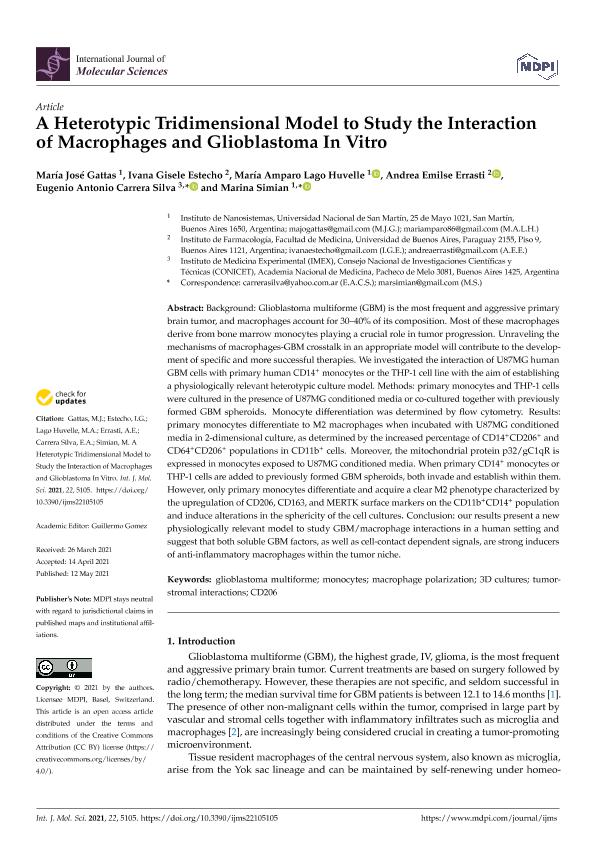Artículo
A heterotypic tridimensional model to study the interaction of macrophages and glioblastoma in vitro
Gattas, María José; Estecho, Ivana Gisele; Lago Huvelle, María Amparo ; Errasti, Andrea Emilse
; Errasti, Andrea Emilse ; Carrera Silva, Eugenio Antonio
; Carrera Silva, Eugenio Antonio ; Simian, Marina
; Simian, Marina
 ; Errasti, Andrea Emilse
; Errasti, Andrea Emilse ; Carrera Silva, Eugenio Antonio
; Carrera Silva, Eugenio Antonio ; Simian, Marina
; Simian, Marina
Fecha de publicación:
05/2021
Editorial:
Molecular Diversity Preservation International
Revista:
International Journal of Molecular Sciences
ISSN:
1422-0067
Idioma:
Inglés
Tipo de recurso:
Artículo publicado
Clasificación temática:
Resumen
Background: Glioblastoma multiforme (GBM) is the most frequent and aggressive primary brain tumor, and macrophages account for 30–40% of its composition. Most of these macrophages derive from bone marrow monocytes playing a crucial role in tumor progression. Unraveling the mechanisms of macrophages-GBM crosstalk in an appropriate model will contribute to the development of specific and more successful therapies. We investigated the interaction of U87MG human GBM cells with primary human CD14+ monocytes or the THP-1 cell line with the aim of establishing a physiologically relevant heterotypic culture model. Methods: primary monocytes and THP-1 cells were cultured in the presence of U87MG conditioned media or co-cultured together with previously formed GBM spheroids. Monocyte differentiation was determined by flow cytometry. Results: primary monocytes differentiate to M2 macrophages when incubated with U87MG conditioned media in 2-dimensional culture, as determined by the increased percentage of CD14+CD206+ and CD64+CD206+ populations in CD11b+ cells. Moreover, the mitochondrial protein p32/gC1qR is expressed in monocytes exposed to U87MG conditioned media. When primary CD14+ monocytes or THP-1 cells are added to previously formed GBM spheroids, both invade and establish within them. However, only primary monocytes differentiate and acquire a clear M2 phenotype characterized by the upregulation of CD206, CD163, and MERTK surface markers on the CD11b+CD14+ population and induce alterations in the sphericity of the cell cultures. Conclusion: our results present a new physiologically relevant model to study GBM/macrophage interactions in a human setting and suggest that both soluble GBM factors, as well as cell-contact dependent signals, are strong inducers of anti-inflammatory macrophages within the tumor niche.
Archivos asociados
Licencia
Identificadores
Colecciones
Articulos(IMEX)
Articulos de INST.DE MEDICINA EXPERIMENTAL
Articulos de INST.DE MEDICINA EXPERIMENTAL
Articulos(OCA HOUSSAY)
Articulos de OFICINA DE COORDINACION ADMINISTRATIVA HOUSSAY
Articulos de OFICINA DE COORDINACION ADMINISTRATIVA HOUSSAY
Citación
Gattas, María José; Estecho, Ivana Gisele; Lago Huvelle, María Amparo; Errasti, Andrea Emilse; Carrera Silva, Eugenio Antonio; et al.; A heterotypic tridimensional model to study the interaction of macrophages and glioblastoma in vitro; Molecular Diversity Preservation International; International Journal of Molecular Sciences; 22; 10; 5-2021; 1-15
Compartir
Altmétricas



